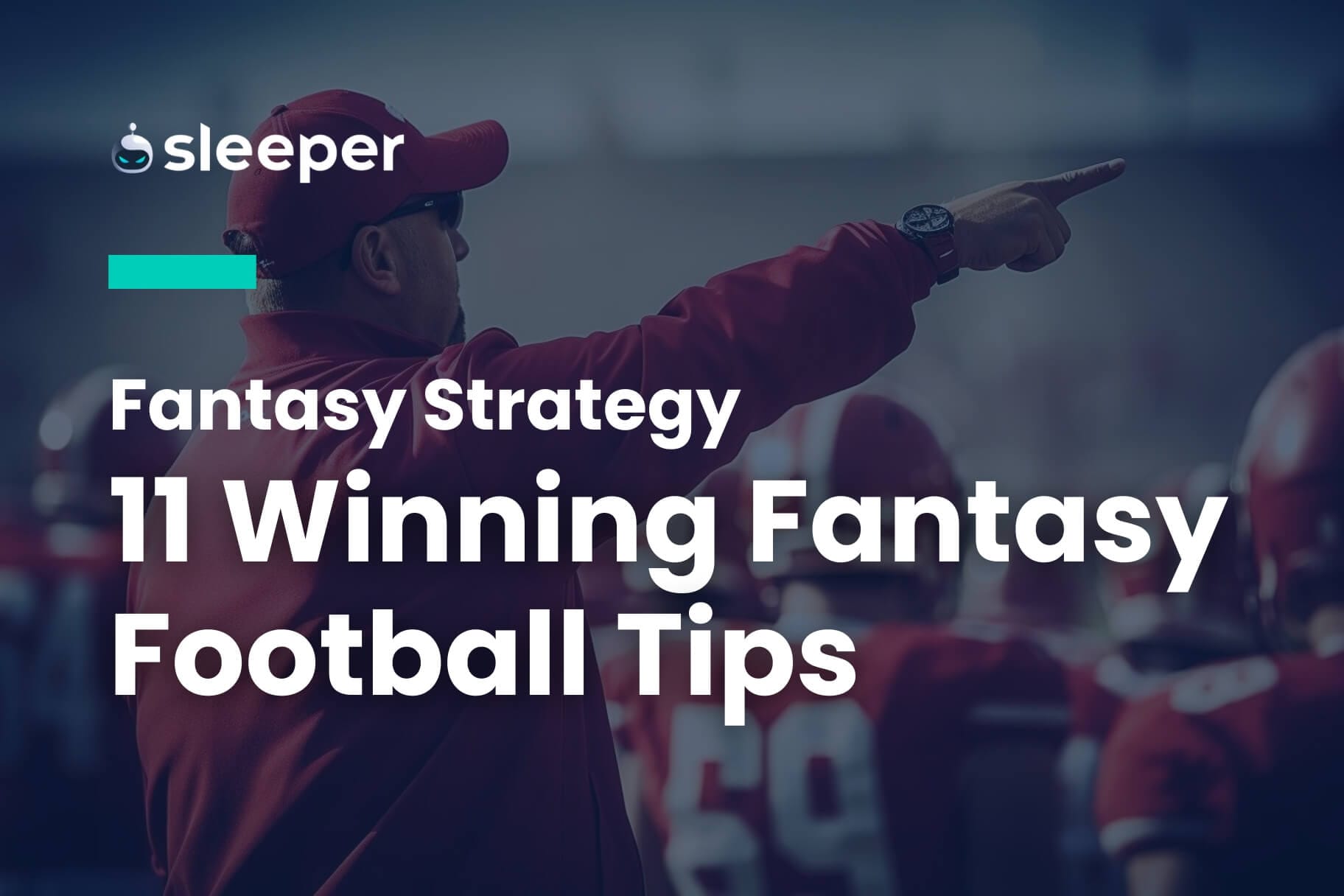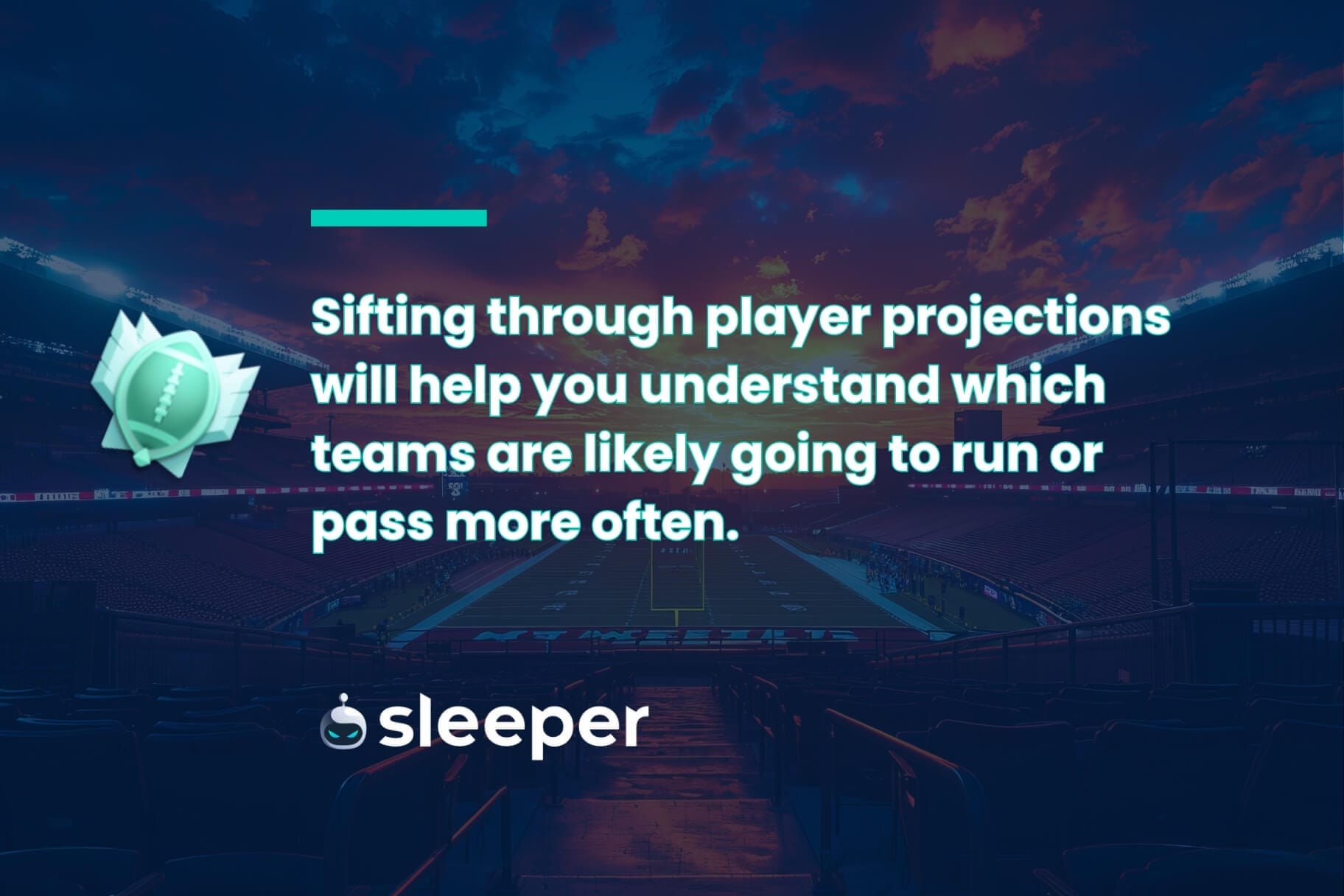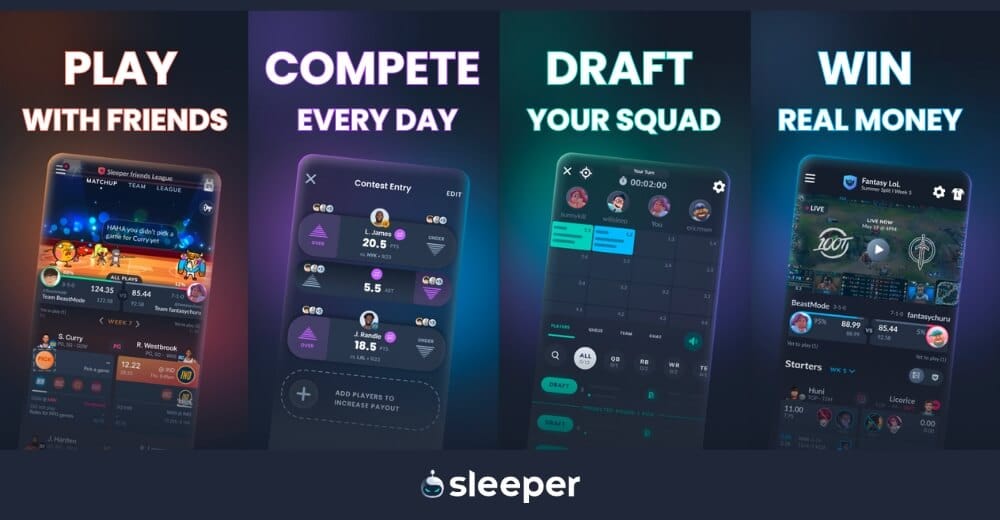Fantasy football is not just a game of luck. Study these strategies ahead of your fantasy football draft to make the experience more fun and enjoyable.

Top 11 Fantasy Football Tips to Win Your League (and Money)
Fantasy football is a game of strategy and skill. Being prepared increases your chances of winning and enjoying the overall draft experience. This article is perfect for newer fantasy managers looking to gain an edge over their league mates with easy-to-implement strategies and tips.
Fantasy Football League Tips
1. Pay attention to starting roster spots
The number of players you start each week in fantasy football is important to monitor. Generally, you’ll want to look at the number of flex spots – RB/WR/TE eligible – for the league, which often ranges from 1-3. One flex spot is the most common arrangement, while additional flex spots will increase the overall number of players starting in your league each week. Leagues with multiple flexes are often called “deep leagues” since managers need to look deeper into the player pool each week to round out their starting lineups.
The actionable takeaway? More flex spots will increase the importance of loading up your RB and WR rooms during the draft, since those are the highest-scoring flex-eligible positions.
Additional flex spots devalue the QB position, too, but superflex fantasy leagues are a way to boost the value of the NFL’s most important position. A superflex spot is similar to a flex, except QBs can also be slotted in. Suddenly, everyone in the league wants to start two QBs each week, and the balance of power shifts. It’s not uncommon to see multiple teams select a QB in Round 1 of a superflex league draft.
While most fantasy leagues require two starting RBs each week, the number of starting WRs varies more frequently. Make sure you know if your league starts two or three WRs each week. In leagues with three starting WR spots, the value of WRs increases slightly relative to the other starting positions.
2. Understand the scoring system
The way receptions are scored varies from league to league, and is often abbreviated as PPR (point per reception). Half-PPR gives 0.5 fantasy points for receptions, while PPR gives a full point for receptions. Standard scoring is becoming less common and does not award any fantasy points for receptions. Standard leagues increase the value of RBs, while PPR leagues favor WRs and pass-catching RBs. Half-PPR falls in between the two.
Some leagues now offer a fantasy point bonus for TE receptions because of how few fantasy points the position traditionally scores. These TE-premium leagues often allocate an extra 0.5 fantasy points for every TE reception.
In a half-PPR league with a TE-premium, 60 receptions from the TE position is now equivalent to a WR recording 120 receptions. You can see how small scoring tweaks can make a big difference in strategy!
Other wrinkles we’ve seen are fantasy points for first downs, long touchdowns or bonuses when a player reaches 100 rushing or receiving yards. If your fantasy football league needs a little more spice for the upcoming season, adding bonuses is a great option.
3. Get to know your league size
The most minor of the three league tips, the number of teams in the league does affect strategy on the margins. Eight-team leagues put a premium on the elite scorers at each position, while a large 14-team league will emphasize roster depth. The most common league size in fantasy football is 12 teams.

Fantasy Football Draft Tips
Fantasy football drafts can be chaotic for novice managers, and the tips in this section will set your team up for success.
4. Balance your draft capital
Think of draft capital as how much you’re investing into each position in fantasy football. If you begin your draft with back-to-back RBs, you’re allotting significant draft capital to your RB room early on. If you draft an elite TE in Round 3, you’ve invested more into that position than opponents who waited until the later rounds to draft a TE.
The guidelines below will help novice fantasy managers stay on track in a typical league:
- Don’t select a QB in Round 1 – unless it’s a superflex league.
- Draft your RB1 before your WR3.
- Draft your WR2 before your RB3.
- Don’t draft your QB2 before your RB4 or WR4.
- Don’t draft your TE2 before your RB4 or WR4.
- Select your kicker and defense in the final two rounds.
There are advanced strategies that occasionally break these rules, but until you have at least half a dozen fantasy drafts under your belt, these guidelines should serve you well.
5. Practice by using mock draft simulators
Practice, practice, practice! In school, studying prepares you for the test. In fantasy football, mock drafting prepares you for the actual draft. Mock drafts are a free and easy way to simulate fantasy football drafts. You’ll still make all the picks, but a computer will rapidly fill out the other rosters in the mock league.
When the mock draft is finished, you can view your roster to see which aspects of the team you’re happy with and which ones you’d change. Keep mock drafting until you’re consistently satisfied with the results.
It’s good to come into a fantasy draft with an initial plan, but often the player you’re targeting is picked one or two slots ahead of you. It’s much easier to avoid panicking on the clock when you’ve practiced with mock drafts ahead of time.
Even if you don’t know your draft slot, mock drafts can still be a great resource. Simply fire up a few different mock drafts from a variety of slots. Creating plans for an early, middle, and late first round pick will calm your nerves leading up to the fantasy draft.
Sleeper is one of the best platforms for mock drafting, since you can easily select the exact same settings as your upcoming fantasy draft. Half-PPR scoring with two flex spots? Quick and easy. A 14-team superflex league with standard scoring? Done.
6. Bring a set of player rankings
Bring a set of rankings you trust to your draft. If you print out the rankings, cross off the players as they’re drafted to keep yourself organized.
Tiered rankings are one step beyond traditional player rankings and make it easier to adjust your strategy on the fly during the draft. If you’re on the clock and deciding between a RB or WR, the amount of available players within a tier can help you make the prudent decision. Select the final WR in a tier if there are six RBs left on the board in the highest remaining tier. There’s a good chance one of those RBs will make it back to you at your next pick.
7. Research player projections
This tip is slightly more advanced. Sifting through player projections will help you understand which teams are likely going to run or pass more often. In a PPR league that rewards reception volume, the WRs in a pass-heavy offense should have higher reception projections than those in a run-first offense.
Projections also aid you in estimating playing time. It’s better to draft a team’s backup RB ahead of their third-stringer, as the backup RB will project for more rush attempts. Rookies are the one category of player that’s difficult to project. No analyst projected Puka Nacua to catch 105 passes as a rookie in 2023. However, projections did flag the Los Angeles Rams as a team lacking WR depth beyond Cooper Kupp that season.
Projections rarely account for injuries, and it’s impossible to know which players will suffer a torn ACL or an ankle sprain during the season. While projections aren’t an exact science, they do provide additional information to curious and analytical fantasy football drafters.
Free and reliable stat projections and player rankings (by ADP) can be found in the Fantasy Football Research section of the Sleeper app.

Fantasy Football Trading Tips
8. Send out win-win trade offers
Create trade offers that help your team, along with your opponent’s. If you need a RB upgrade and a foe needs a WR upgrade, try to trade one of your WRs for one of their RBs. This type of trade is likely to get accepted because it clearly benefits both teams.
A common trade tactic by new fantasy managers is offering two or three of your worst players for someone’s best player. Trades like this are not going to get accepted and they can ruin your credibility within the league. Don't try it.
Part of the fun of trading is the creativity behind it. Some platforms like Sleeper even let you create three-team trades to engage a larger portion of your league at once. His RB for her WR for their TE? Why not!
9. Learn the tendencies of your league mates
This goes hand in hand with win-win offers. If someone in your league is a Bears fan, you’ll probably have a tough time prying D.J. Moore away from them.
Let’s imagine the fantasy manager in your league who was the first person to take a QB in the draft. News comes out that their star QB will miss four weeks due to injury. We already have intel that this manager values the QB position highly, so you may be able to pry away a RB or WR in exchange for your healthy, starting QB.
10. You’re allowed to counter trade offers
Sometimes you’ll receive a trade that almost looks like the right move for your team. If an incoming offer is nearly there, it’s perfectly acceptable – and very common – to respond with a counter offer. Newer fantasy managers are encouraged to consult fantasy trade calculators to make sure incoming offers are fair on paper.
11. Don’t collude with friends
Trade vetoes are a common feature of many leagues. Some platforms won’t even allow extremely unbalanced trades. In fact, it's common for a manager to get kicked out of a league for getting caught bribing a friend to accept a terrible offer. Trust us, your league mates can sniff foul play from miles away!
Frequently Asked Questions
Is fantasy football skill or luck?
Fantasy football is a mixture of both skill and luck. There is skill in the pre-draft prep and the ability to adapt during the draft when chaos inevitably hits. The strategies listed above are designed to help you inject more skill into the game of fantasy football. However, football is a contact sport and injuries happen, so there is definitely a luck component with your team’s ability to stay healthy.
How do I make my fantasy team better?
Trading is a great way to improve your team. Focus on mutually beneficial trade offers to build trust and increase your chances of the offer being accepted. Another option is adding talent through free agents and the waiver wire. You’ll have to be adept at identifying talent (and aggressive at bidding if your league adopts a Free Agent Acquisition Budget (FAAB) format), but on a week-to-week basis, it’s your best bet for improvement.
Is there a certain position I should draft with my first pick?
It’s fairly common – and recommended – to take a RB or WR with your first pick… For 2024, RBs like Christian McCaffrey, Breece Hall and Bijan Robinson or WRs like CeeDee Lamb, Tyreek Hill and Ja’Marr Chase are strong picks in Round 1. QB or TE is rarely the best option with your initial pick.
If I already play season-long fantasy football, how easy is it to learn daily fantasy football?
Season-long fantasy football, or redraft, is a great base if you decide to expand to daily fantasy sports (DFS) games. Simply select more or less for an individual player’s predicted stats (yards, touchdowns, etc.) for any week during the NFL season. If you pick right, you win.
For example, Bijan Robinson may have a rushing yards projection of 72.5 yards in Week 7, and you’d need to determine if he’s going over or under that amount of rushing yards. If you want to learn more about this popular complement to redraft, be sure to check out Sleeper Picks.
Concluding Thoughts
Fantasy football should always be a fun break from our day-to-day lives, but it never hurts to aim for success. All the tips in this article can be implemented leading up to and during the draft to increase your chances of winning your league.
Fantasy football enthusiasts can create or join a league on Sleeper for the best fantasy football league experience. Customizable league settings, a slick interface and unique group chat capabilities are only a few of the many great features the app has to offer.
Another way to enjoy fantasy football each week is through Sleeper Picks, a daily fantasy sports (DFS) offering where you make weekly picks during the NFL season. NBA, MLB and other league picks are also available for the year-round fantasy sports fan.




